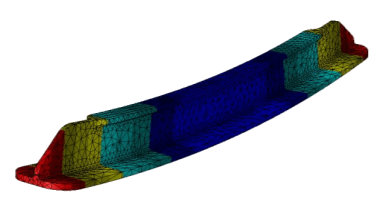Tricky subsurface residual stresses due to machining distorting your part? Need to simulate the influence of cold working sequence for a given hole pattern? Residual stresses (RS) can have a significant impact on the strength, durability and damage tolerance of metallic and composite parts. Distortion caused by residual stresses poses difficult problems in manufacturing of large, lightweight components.
Residual Stress Modules

StressCheck has already provided millions of dollars of savings to customers with its residual stress machining solutions. With proven error control in StressCheck, distortion caused by machining processes, surface treatments, or bulk material residual stresses are reliably predicted. Guaranteed reliability = higher ROI.
Key Features and Advantages
- StressCheck is ideally suited for solving difficult problems such as estimating the strength of cold worked structural connections where residual stresses are present and the stress changes rapidly over short distances.
- The Subsurface residual stress (SRS) module can apply experimentally-measured cold working residual stresses to a part, if they are known.
- An automated analysis tool that simulates the cold working process by superposition and provides the analyst with the residual state of stress resulting from pulling an oversize mandrel through a single fastener hole is available via the Cold Working Solver.
- Mandrel insertion (local plasticity around the hole)
- Mandrel removal (CW residual stress)
- Final state of stress (CW residual + applied load).
- The Non-Linear Solver, a more general solver, is capable of solving multiple fastener holes and including the effects of reverse plasticity in the analysis.
- StressCheck has powerful machining residual stress (RS) capabilities, included in the bulk residual stress (BRS) and subsurface residual stress (SRS) modules.
- Apply stress or strain profiles representing machining processes or surface treatments to all surfaces of a complex component – then predict part distortion.
- Use predefined stress or strain profile shapes, optimized for computational efficiency, or define your own general formulae.
- Machining or surface treatment profiles perfectly follow curved surfaces of CAD geometry.
- Import a residual stress field from a forging simulation and compute distortion by virtually machining material away.
- Compute the redistribution of residual stresses due to machining as input for fatigue calculations.
- Simulate multi-step machining processes, taking into account the effect of bulk material residual stress.
- Simulate the redistribution of residual stress after material removal (for example, from reaming).
- Specify bulk residual stress within a part so that fracture mechanics parameters (SIFs KI, KII, KIII or J-integral JI, JII, JIII) can take into account the effects of the residual stress.
- Apply a stress or strain distribution to surfaces of a part, in order to simulate the residual stress redistribution or distortion caused by machining or surface treatments.
- In some cases it can be useful to specify bulk residual stresses (such as those from an experimentally-measured cold working residual stress distribution around a hole) using the subsurface residual stress (SRS) load rather than the bulk residual stress (BRS) load, but the end result is the same.
Looking for Resources?
Recent News & Events
Quick Links
Testimonials
-
When performing parametric structural analysis, ESRD’s p-element StressCheck FEA software is always my preferred choice due to the excellent solution quality, parametric framework, and superior computational efficiency. In fact, I recently used StressCheck to generate stress intensity factors along a parametrically defined elliptical crack-tip across 3,000 unique geometric configurations. Considering multi-body contact was present and all simulations were performed using a laptop, this was a task well suited for StressCheck.
Dr. Lee Zambino
Researcher, Villanova University
 Serving the Numerical Simulation community since 1989
Serving the Numerical Simulation community since 1989 





